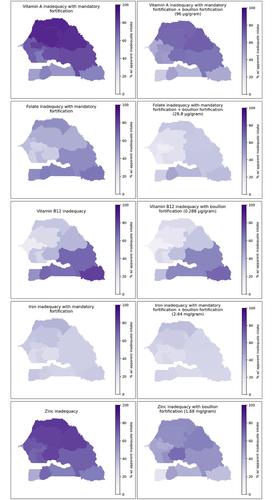当前位置:
X-MOL 学术
›
Ann. N. Y. Acad. Sci.
›
论文详情
Our official English website, www.x-mol.net, welcomes your feedback! (Note: you will need to create a separate account there.)
The potential contributions of bouillon fortification to meeting micronutrient requirements among women and preschool children in Senegal: A modeling study using household consumption and expenditure survey data
Annals of the New York Academy of Sciences ( IF 4.1 ) Pub Date : 2024-07-08 , DOI: 10.1111/nyas.15156 Katherine P. Adams 1 , Stephen A. Vosti 1, 2 , Ann Tarini 3 , Maguette Beye 4 , Helena Pachón 5, 6 , Sophia Kiselova 7 , Reina Engle‐Stone 1
Annals of the New York Academy of Sciences ( IF 4.1 ) Pub Date : 2024-07-08 , DOI: 10.1111/nyas.15156 Katherine P. Adams 1 , Stephen A. Vosti 1, 2 , Ann Tarini 3 , Maguette Beye 4 , Helena Pachón 5, 6 , Sophia Kiselova 7 , Reina Engle‐Stone 1
Affiliation

|
To reduce micronutrient deficiencies, Senegal mandates the fortification of refined oil with vitamin A and wheat flour with iron and folic acid. Expanding Senegal's large-scale food fortification programs to include fortified bouillon could help fill the remaining gaps in dietary micronutrient requirements. Using 7-day household food consumption data collected between 2018 and 2019, we assessed the potential contributions of bouillon fortified with vitamin A (40–250 μg/g bouillon), folic acid (20–120 μg/g), vitamin B12 (0.2–2 μg/g), iron (0.6–5 mg/g), and zinc (0.6–5 mg/g) for meeting micronutrient requirements of women of reproductive age (WRA; 15–49 years old) and children (6–59 months old). Most households (90%) reported consuming bouillon, including poor and rural households. At modeled fortification levels, bouillon fortification reduced the national prevalence of inadequacy by up to ∼20 percentage points (pp) for vitamin A, 34 pp (WRA) and 20 pp (children) for folate, 20 pp for vitamin B12, 38 pp (WRA) and 30 pp (children) for zinc, and ∼8 pp for iron. Predicted reductions in inadequacy were generally larger among poor and rural populations, especially for vitamins A and B12. Our modeling suggests that bouillon fortification has the potential to substantially reduce dietary inadequacy of multiple micronutrients and could also help address inequities in dietary micronutrient inadequacies in Senegal.
中文翻译:

肉汤强化对满足塞内加尔妇女和学龄前儿童微量营养素需求的潜在贡献:利用家庭消费和支出调查数据进行的建模研究
为了减少微量营养素缺乏,塞内加尔要求在精炼油中强化维生素 A,在小麦粉中强化铁和叶酸。扩大塞内加尔的大规模食品强化计划,将强化肉汤纳入其中,有助于填补膳食微量营养素需求方面的剩余空白。利用 2018 年至 2019 年间收集的 7 天家庭食品消费数据,我们评估了维生素 A 强化肉汤(40–250 µg/g 肉汤)、叶酸(20–120 µg/g)、维生素 B12(0.2 –2 µg/g)、铁 (0.6–5 mg/g) 和锌 (0.6–5 mg/g),以满足育龄妇女(WRA;15–49 岁)和儿童(6– 59 个月大)。大多数家庭(90%)报告消费肉汤,包括贫困家庭和农村家庭。在模拟强化水平上,肉汤强化将全国维生素 A 不足率降低了 20 个百分点 (pp),维生素 A 降低了 34 个百分点 (WRA),叶酸降低了 20 个百分点(儿童),维生素 B12 降低了 20 个百分点,维生素 B12 降低了 38 个百分点(儿童)。 WRA)和锌 30 pp(儿童),铁 ∼8 pp。预计贫困人口和农村人口的不足量减少幅度通常更大,尤其是维生素 A 和 B12。我们的模型表明,肉汤强化有可能大幅减少多种微量营养素的膳食不足,还可以帮助解决塞内加尔膳食微量营养素不足的不平等问题。
更新日期:2024-07-08
中文翻译:

肉汤强化对满足塞内加尔妇女和学龄前儿童微量营养素需求的潜在贡献:利用家庭消费和支出调查数据进行的建模研究
为了减少微量营养素缺乏,塞内加尔要求在精炼油中强化维生素 A,在小麦粉中强化铁和叶酸。扩大塞内加尔的大规模食品强化计划,将强化肉汤纳入其中,有助于填补膳食微量营养素需求方面的剩余空白。利用 2018 年至 2019 年间收集的 7 天家庭食品消费数据,我们评估了维生素 A 强化肉汤(40–250 µg/g 肉汤)、叶酸(20–120 µg/g)、维生素 B12(0.2 –2 µg/g)、铁 (0.6–5 mg/g) 和锌 (0.6–5 mg/g),以满足育龄妇女(WRA;15–49 岁)和儿童(6– 59 个月大)。大多数家庭(90%)报告消费肉汤,包括贫困家庭和农村家庭。在模拟强化水平上,肉汤强化将全国维生素 A 不足率降低了 20 个百分点 (pp),维生素 A 降低了 34 个百分点 (WRA),叶酸降低了 20 个百分点(儿童),维生素 B12 降低了 20 个百分点,维生素 B12 降低了 38 个百分点(儿童)。 WRA)和锌 30 pp(儿童),铁 ∼8 pp。预计贫困人口和农村人口的不足量减少幅度通常更大,尤其是维生素 A 和 B12。我们的模型表明,肉汤强化有可能大幅减少多种微量营养素的膳食不足,还可以帮助解决塞内加尔膳食微量营养素不足的不平等问题。












































 京公网安备 11010802027423号
京公网安备 11010802027423号